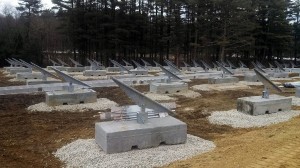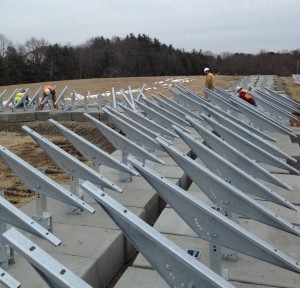Ballasted ground-mounts work just as well as penetrating ones, especially when it comes to difficult land conditions.
Visions of large ground-mounted solar projects consist of large posts drilled into the earth, with dirt and small rocks being hauled away. But not all ground conditions are ideal for a penetrating system. Ballasted mounting systems can work just as well on the ground as they do on rooftops. Patriot Solar Group has a ballasted ground-mount that has seen success at landfills, brownfields and among rocky soil conditions.
 “Landfill caps cannot be penetrated at all so you cannot use a post-driven solution,” says Adam Parr, account manager for Patriot Solar. “Brownfields cannot have any major soil disturbance. For rocky soils, you can drive posts but you then run into possibly hitting rock and throwing off your array.”
“Landfill caps cannot be penetrated at all so you cannot use a post-driven solution,” says Adam Parr, account manager for Patriot Solar. “Brownfields cannot have any major soil disturbance. For rocky soils, you can drive posts but you then run into possibly hitting rock and throwing off your array.”
These difficult ground conditions are usually the cheaper alternative for solar power compared to lush, green landscapes.
“When you look at the cost of the land of [difficult ground areas] compared to a pristine farm field or other ‘building suited’ land, it makes sense to go with inexpensive or otherwise unusable land,” Parr says.
Parr describes Patriot Solar’s ballasted ground-mount as “simple, with minimal parts and ease of use, all while providing the most functionality.” The system consists of: a cement block with adjusting plates that come pre-poured to site; a post that can be adjusted up and down for height differences and 10 to 30° to accommodate slopes; a truss which can be adjusted to the desired module tilt from 10 to 40°; and rails that hold five panels before sliding onto the next rail.
Patriot’s standard ballast block meets a 100 mph wind-load. For large projects, the company provides civil engineering assistance to ensure the ballast system meets desired criteria.
“We have built-in fork pockets for ease of use and can add a jagged edge that cuts into the dirt to prevent erosion or slippage,” Parr says. “Duck bills or earth anchors can be used as well if you have a slope to prevent sliding. You can also size the block smaller and add duck bills to use less cement and still meet the desired wind loads.”
Ballasted ground-mounts are more expensive than post-driven systems, mostly from the additional costs in concrete. But considering the costs associated with site prep and excavation (for rocky conditions) in addition to the added labor, the costs are pretty comparable for the two systems.
Patriot Solar Group began first as a manufacturer of fixed and tracking ground-mounts but soon saw a market demand for ballasted systems, so they were added to the product line-up.
 “More and more landfills are being developed because it is land that is otherwise unusable,” Parr says. “Poor soils and unusable land make the cost of the land much less expensive. [And] there are no other options. They have to be ballasted.”
“More and more landfills are being developed because it is land that is otherwise unusable,” Parr says. “Poor soils and unusable land make the cost of the land much less expensive. [And] there are no other options. They have to be ballasted.”
Patriot Solar recently completed a 3.4-MW array in Massachusetts, which is notorious for rocky conditions. It was decided to use both post-driven and ballasted ground mounts for the largest ground-mounted solar farm in the state.
“The Western array was post-driven because geo tech results showed little rock in the soils below,” Parr says. “We ended up hitting rock in six to seven post locations, so we put a ballast block in its place. It was a simple fix.”
Patriot’s unique telescoping post has a multiple-angle adjustment plate that allows for height alteration with 10 to 30° of tilt variance. This allows the block to follow the contour of the land and keep in line with both post-driven sections and other ballasted sections of the array. Instead of laboring over removing large rocks, using ballasted ground mounts next to penetrating mounts saved crews time and money.
“With our ability to adjust the post height and tilt, we minimize the amount of site prep and can combat variations in slope,” Parr says. “Our design allows installation of racking and panels to take place on the ground without any heavy machinery or scaffolding.”
The next time developers run into rough terrain, a ballasted ground-mount could be the simple solution to a complicated installation problem.
— Solar Builder magazine
[source: http://www.solarbuildermag.com/featured/ballasted-ground-mounted-solar/]

Leave a Reply
You must be logged in to post a comment.